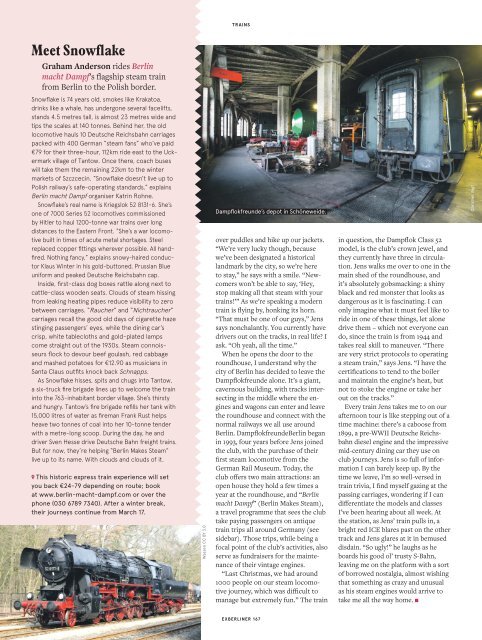Exberliner Issue 167, January 2018
Create successful ePaper yourself
Turn your PDF publications into a flip-book with our unique Google optimized e-Paper software.
TRAINS<br />
Meet Snowflake<br />
Graham Anderson rides Berlin<br />
macht Dampf’s flagship steam train<br />
from Berlin to the Polish border.<br />
Snowflake is 74 years old, smokes like Krakatoa,<br />
drinks like a whale, has undergone several facelifts,<br />
stands 4.5 metres tall, is almost 23 metres wide and<br />
tips the scales at 140 tonnes. Behind her, the old<br />
locomotive hauls 10 Deutsche Reichsbahn carriages<br />
packed with 400 German “steam fans” who’ve paid<br />
€79 for their three-hour, 112km ride east to the Uckermark<br />
village of Tantow. Once there, coach buses<br />
will take them the remaining 22km to the winter<br />
markets of Szczcecin. “Snowflake doesn’t live up to<br />
Polish railway’s safe-operating standards,” explains<br />
Berlin macht Dampf organiser Katrin Rohne.<br />
Snowflake’s real name is Kriegslok 52 8131-6. She’s<br />
one of 7000 Series 52 locomotives commissioned<br />
by Hitler to haul 1200-tonne war trains over long<br />
distances to the Eastern Front. “She’s a war locomotive<br />
built in times of acute metal shortages. Steel<br />
replaced copper fittings wherever possible. All handfired.<br />
Nothing fancy,” explains snowy-haired conductor<br />
Klaus Winter in his gold-buttoned, Prussian Blue<br />
uniform and peaked Deutsche Reichsbahn cap.<br />
Inside, first-class dog boxes rattle along next to<br />
cattle-class wooden seats. Clouds of steam hissing<br />
from leaking heating pipes reduce visibility to zero<br />
between carriages. “Raucher” and “Nichtraucher”<br />
carriages recall the good old days of cigarette haze<br />
stinging passengers’ eyes, while the dining car’s<br />
crisp, white tablecloths and gold-plated lamps<br />
come straight out of the 1930s. Steam connoisseurs<br />
flock to devour beef goulash, red cabbage<br />
and mashed potatoes for €12.90 as musicians in<br />
Santa Claus outfits knock back Schnapps.<br />
As Snowflake hisses, spits and chugs into Tantow,<br />
a six-truck fire brigade lines up to welcome the train<br />
into the 763-inhabitant border village. She’s thirsty<br />
and hungry. Tantow’s fire brigade refills her tank with<br />
15,000 litres of water as fireman Frank Rust helps<br />
heave two tonnes of coal into her 10-tonne tender<br />
with a metre-long scoop. During the day, he and<br />
driver Sven Hesse drive Deutsche Bahn freight trains.<br />
But for now, they’re helping “Berlin Makes Steam”<br />
live up to its name. With clouds and clouds of it.<br />
This historic express train experience will set<br />
you back €24-79 depending on route; book<br />
at www.berlin-macht-dampf.com or over the<br />
phone (030 6789 7340). After a winter break,<br />
their journeys continue from March 17.<br />
Wassen CC BY 3.0<br />
Dampflokfreunde’s depot in Schöneweide.<br />
over puddles and hike up our jackets.<br />
“We’re very lucky though, because<br />
we’ve been designated a historical<br />
landmark by the city, so we’re here<br />
to stay,” he says with a smile. “Newcomers<br />
won’t be able to say, ‘Hey,<br />
stop making all that steam with your<br />
trains!’” As we’re speaking a modern<br />
train is flying by, honking its horn.<br />
“That must be one of our guys,” Jens<br />
says nonchalantly. You currently have<br />
drivers out on the tracks, in real life? I<br />
ask. “Oh yeah, all the time.”<br />
When he opens the door to the<br />
roundhouse, I understand why the<br />
city of Berlin has decided to leave the<br />
Dampflokfreunde alone. It’s a giant,<br />
cavernous building, with tracks intersecting<br />
in the middle where the engines<br />
and wagons can enter and leave<br />
the roundhouse and connect with the<br />
normal railways we all use around<br />
Berlin. DampflokfreundeBerlin began<br />
in 1993, four years before Jens joined<br />
the club, with the purchase of their<br />
first steam locomotive from the<br />
German Rail Museum. Today, the<br />
club offers two main attractions: an<br />
open house they hold a few times a<br />
year at the roundhouse, and “Berlin<br />
macht Dampf” (Berlin Makes Steam),<br />
a travel programme that sees the club<br />
take paying passengers on antique<br />
train trips all around Germany (see<br />
sidebar). Those trips, while being a<br />
focal point of the club’s activities, also<br />
serve as fundraisers for the maintenance<br />
of their vintage engines.<br />
“Last Christmas, we had around<br />
1000 people on our steam locomotive<br />
journey, which was difficult to<br />
manage but extremely fun.” The train<br />
in question, the Dampflok Class 52<br />
model, is the club’s crown jewel, and<br />
they currently have three in circulation.<br />
Jens walks me over to one in the<br />
main shed of the roundhouse, and<br />
it’s absolutely gobsmacking: a shiny<br />
black and red monster that looks as<br />
dangerous as it is fascinating. I can<br />
only imagine what it must feel like to<br />
ride in one of these things, let alone<br />
drive them – which not everyone can<br />
do, since the train is from 1944 and<br />
takes real skill to maneuver. “There<br />
are very strict protocols to operating<br />
a steam train,” says Jens. “I have the<br />
certifications to tend to the boiler<br />
and maintain the engine’s heat, but<br />
not to stoke the engine or take her<br />
out on the tracks.”<br />
Every train Jens takes me to on our<br />
afternoon tour is like stepping out of a<br />
time machine: there’s a caboose from<br />
1899, a pre-WWII Deutsche Reichsbahn<br />
diesel engine and the impressive<br />
mid-century dining car they use on<br />
club journeys. Jens is so full of information<br />
I can barely keep up. By the<br />
time we leave, I’m so well-versed in<br />
train trivia, I find myself gazing at the<br />
passing carriages, wondering if I can<br />
differentiate the models and classes<br />
I’ve been hearing about all week. At<br />
the station, as Jens’ train pulls in, a<br />
bright red ICE blares past on the other<br />
track and Jens glares at it in bemused<br />
disdain. “So ugly!” he laughs as he<br />
boards his good ol’ trusty S-Bahn,<br />
leaving me on the platform with a sort<br />
of borrowed nostalgia, almost wishing<br />
that something as crazy and unusual<br />
as his steam engines would arrive to<br />
take me all the way home. n<br />
Christian Vagt<br />
EXBERLINER <strong>167</strong>


















